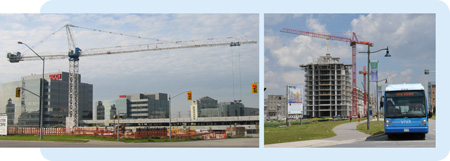
There might have been a time when, as it grew, a community could just continue to expand its boundaries farther out into the surrounding countryside, adding new neighbourhoods as more people moved in. But in our increasingly crowded part of the province, we’re long past the time when municipalities can just spread out endlessly – our boundaries are pretty much fixed. So finding room for new people has to happen within our existing space.
With provincial legislation setting out formal growth targets for all Ontario communities, York Region has had to do some careful planning to map out where all those new people are going to live. And we’re not talking small increases – our planners have projected that by 2031, York Region will need to find room for an additional 577,000 residents and 234,000 households. And those new people need places to work, so planners also need to factor in room for an additional 180 million square feet of employment floor space, to accommodate the 318,000 new jobs that will be needed.
York Region is pretty big, so maybe those people can all spread out? No, it’s not that easy. In the first place, although some people prefer to live in more rural settings, the majority of people in York Region want to live close to amenities – near schools, near stores, near entertainment – near all the great things that make city life interesting and convenient. And those things tend to be clustered at the heart of our existing larger communities, like Markham, Newmarket, Richmond Hill and Vaughan.
Secondly, although York Region is quite large geographically, a lot of our lands are actually very fragile environments, and are protected against significant development. In fact, nearly 70% of our total land is protected under either the Green Belt Act, or the Oak Ridges Moraine Act.
To make this a win-win for everyone, the Region has adopted a planning strategy that directs almost half of the expected new growth to existing built-up areas, with the other half going to new development areas. This approach will result in more opportunities for people to live, work and play in the neighbourhoods that they already know and love, while reducing some of the growth pressure on the surrounding countryside.
The Region’s Centres and Corridors – which include the cores of Markham, Newmarket, Richmond Hill and Vaughan – will play an important role in this growth strategy. Most of the growth that will occur within the Region’s existing urban area will take place in the Centres and Corridors. With this concentration of growth, people will find it easier to get around using existing and planned rapid transit services, and to enjoy the exciting mix of living, employment, shopping and entertainment options that are already there, and that will continue to evolve.
Those of us working on vivaNext are excited about this plan, because it will put transit at the centre of the action as York Region grows into the future. I’d love to hear what you think of this vision, and what it will mean for how you live your life in York Region?
